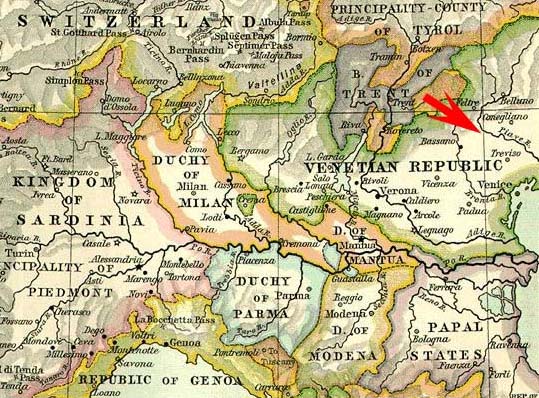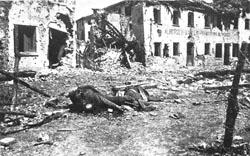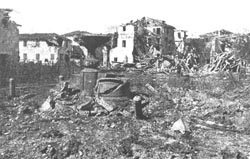| 4 | The Camillo Story |
Nervesa
della Battaglia
Nervesa
is a small Veneto town which lies about 50 kms from Venice, at the foot
of the Montello hill, by the river Piave at the point where it changes
from a rushing mountain stream, into a wide placid river as it reaches the
plain.

The
Montello hill is a terminal moraine, composed of rocks and earth deposited
by an enormous glacier, that during an Ice Age, arrived this far from the
Alps. The forest that grew there supposedly supplied the wooden poles
that served as foundations to support the buildings of the city of Venice
and lumber for its shipyards.
Nervesa’s
favourable geographical location encouraged its human habitation well into
the past and the stone utensils found there show its occupation even from
paleolithic times, 60,000 years ago. The numerous caves of the Montello
provided primitive shelter to these first tribes, who contended them with
the giant cave-dwelling bears of the time.
Agriculture
was first experimented at Nervesa about 5000 B.C., but the town acquired a
commercial importance from its crucial position on the River Piave. It
controlled the transit of goods between the alpine areas and the plain; in
fact there was much traffic up and down the river on wooden rafts, which continued right up to the present century, to the 1920s.
The
first historic reference to Nervesa, came from King Otto III, who cites
"in vico Nervesae iuxta fluviam Plavam" (in the town of Nervesa
close to the river Piave), in 994 when the German king granted feudal
dominion of Nervesa and the Montello to the Collalto family. In the early
1000, this family (whose name translates as "High Hill") founded
there a Benedictine Abbey and in the 1300s, the Certosa Convent.
As
the name of the town implies, Nervesa della Battaglia was the centre of a
great battle during the first world war and the war memorial on the
Montello, is a solemn reminder. On this hill there is also a monument
marking the spot where the fighter pilot hero, Francesco Baracca, crashed
to his death in 1918, after having been shot down by the Austrians. He
himself had downed a total of 34 enemy planes in 63 aerial combats.


The
Montello played an important part in the First World War as a defensive
stronghold of the Italian Army against the occupying Austrians, who were
on the other side of the river Piave. On the 15th of June 1918, the enemy
made a heavy frontal attack, crossing the river and managed to take
Nervesa and Giavera.
A
few days later, on the 19th, the Italians made a heavy counterattack,
centred right around Nervesa and after a bloody battle with heavy losses
on both sides, they succeeded in pushing back the Austrians. They fiercely
defended the town till the end of the war.
During
the battle Nervesa was reduced to rubble, including the famous abbey of
Collalto and Villa Soderini, with all its Tiepolo frescoes. (In this abbey,
Monseignor Giovanni Della Casa wrote the famous "Galateo" in
1558, a book, which became the bible for all Italians, of good manners, of
conversing, dressing, eating and general good behaviour towards others).
Celeste Camillo's testimony tells that at the start of the shellings, the soldiers arrived to tell them to evacuate their house, so he tied the cow to the cart, quickly killed a pig with a hoe, tossed it on and fled with these few precious possessions. It was just in time, as their house was destroyed, as it provided a critical military observation point.
l-camillo.com
Copyright L. Camillo 2000